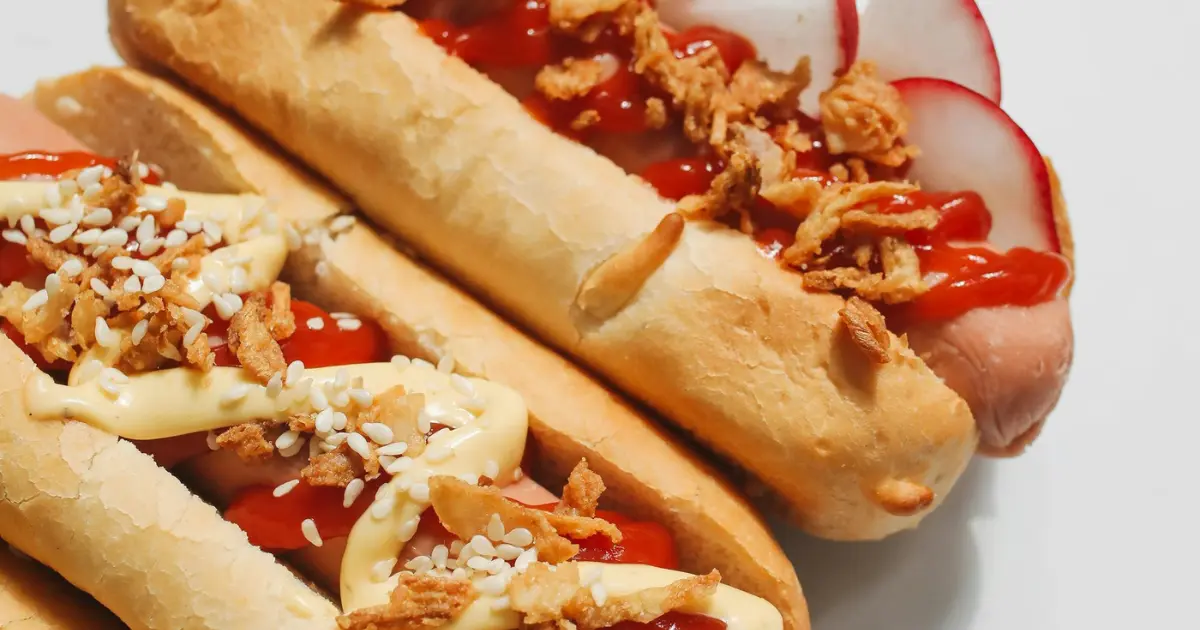Hot Dogs: The Iconic Street Food of the USA
Hot Dogs street food usa
Hot dogs are a key part of American street food, loved by many. They are found everywhere, from New York City to California’s beaches. This simple food has become a symbol of the country’s rich food culture .
The story of hot dogs starts with German immigrants who brought their sausage traditions to the US. Over time, hot dogs have changed to fit American tastes. Now, they’re a big part of county fairs, baseball games, and city streets, with each place adding its own special touch.
Key Takeaways
- Hot dogs are a quintessential part of American street food culture.
- The origins of hot dogs can be traced back to German immigrants and their sausage-making traditions.
- Hot dogs have become a symbol of the diverse and dynamic food culture in the United States.
- Hot dogs can be found at a variety of venues, from baseball stadiums to street festivals.
- Regional and vendor-specific variations have contributed to the enduring popularity of hot dogs in the United States.
The Rich History of Hot Dogs in American Street Food Culture
The humble frankfurter, or wiener, has a fascinating history. It is deeply intertwined with American street food. German immigrants brought the frankfurter to the US, making it a staple in American cuisine.
Origins in German Immigration
In the 19th century, German immigrants introduced the frankfurter to the US. They brought their love for this savory sausage. Early vendors sold frankfurters from carts in cities like New York and Chicago.
Evolution on American Streets
Street vendors soon started adding new toppings to the frankfurter. Mustard, relish, and sauerkraut turned it into a uniquely American dish. The frankfurter became a symbol of urban life and changing tastes.
Rise of Hot Dog Carts
In the late 19th and early 20th centuries, frankfurter carts became common. They served factory workers, immigrants, and city dwellers. The hot dog cart made the frankfurter a true American street food.
What Makes a Perfect Street Hot Dog
Making the perfect street hot dog is all about quality and care. The hot dog bun is key, being soft and strong enough for the sausage. The sausage quality must be great, with a taste that excites and a texture just right.
Street vendors know how to make a hot dog special. They use a grill for that perfect sizzle and make sure the bun is just right. The sausage is cooked to the perfect temperature, making every bite a delight.
| Component | Ideal Characteristics |
|---|---|
| Hot Dog Bun | Soft, pillowy texture that can hold the sausage without falling apart. |
| Sausage | Flavorful, with a consistent texture that is neither too firm nor too soft. |
| Cooking Method | Sizzling grill, evenly toasted bun, and the perfect serving temperature. |
The perfect street hot dog is a mix of flavors and textures. Each part works together for a great taste. The sausage, bun, and cooking methods all come together to make a favorite street food.
Regional Hot Dog Styles Across America
America is a mix of many cuisines, and hot dogs are no different. From Chicago-style dogs to Coney Island specials, each area has its own twist. Let’s dive into the diverse hot dog styles that Americans love.
Chicago-Style Dogs
In Chicago, hot dogs are a big deal. They have a juicy all-beef frank, in a soft bun. It’s topped with green relish, sport peppers, a pickle, tomato, and yellow mustard. This mix of flavors is amazing.
New York Pushcart Dogs
New York City’s pushcart hot dogs are famous. They’re grilled, put in a steamed bun, and topped with various hot dog toppings. You can get classic sauerkraut or try something new like bacon-wrapped and chili-cheese.
Coney Island Specials
- The Coney Island hot dog comes from New York’s famous Coney Island.
- It’s an all-beef dog, grilled, and covered in a meat sauce, onions, and creamy mustard.
- This mix of flavors and textures makes the Coney Island dog a favorite everywhere.
West Coast Variations
On the West Coast, hot dogs are fancy. In Los Angeles, you can find the “danger dog” with bacon, sautéed onions, and salsa. In Seattle, there’s a dog with cream cheese and grilled onions. These toppings show the West’s creativity in food.
Famous Hot Dog Vendors and Their Stories
The iconic hot dog stands across America are more than just food stalls. They are a testament to the rich history of family-owned businesses and street food entrepreneurs. These vendors have won the hearts and taste buds of many, both locals and tourists.
For example, Katz’s Delicatessen in New York City has been around since 1888. It’s a must-visit for its New York-style hot dogs and other Jewish deli favorites. The Katz family’s dedication to quality and tradition has made it a beloved spot in the Big Apple.
In Chicago, Portillo’s Hot Dogs is all about the Chicago-style hot dog. Started by Dick Portillo in 1963, it now has over 60 locations. Yet, it still serves up delicious, freshly-made hot dogs that have a loyal fan base.
On the West Coast, Pink’s Hot Dogs in Los Angeles is a favorite for street food lovers. Opened in 1939 by Paul and Betty Pink, it’s known for its unique toppings and signature chili dogs. It’s a cultural landmark that draws in crowds.
| Iconic Hot Dog Stand | Location | Founding Year | Signature Offering |
|---|---|---|---|
| Katz’s Delicatessen | New York City | 1888 | New York-style hot dogs |
| Portillo’s Hot Dogs | Chicago | 1963 | Chicago-style hot dogs |
| Pink’s Hot Dogs | Los Angeles | 1939 | Signature chili dogs |
These family-owned businesses and street food entrepreneurs have done more than just serve tasty hot dogs. They have become key parts of their communities. They help keep alive the traditions and flavors that make American street food so special.
Essential Hot Dog Toppings and Condiments
Hot dogs are a favorite in America, and the toppings and condiments are key. From mustard and ketchup to unique regional and gourmet options, you can make your hot dog your own.
Classic Condiments
No hot dog is complete without mustard and ketchup. These have been hot dog staples for years. Relish, a sweet pickle-based topping, adds a tangy flavor.
Regional Specialty Toppings
- Onions are a must in Chicago-style hot dogs. Sauerkraut is a key topping for New York-style dogs.
- Coney Island dogs have chili sauce and shredded cheese.
- On the West Coast, hot dogs get toppings like avocado, bacon, and pineapple.
Modern Gourmet Options
The hot dog scene has grown, and so have the toppings. Now, you can find gourmet toppings like caramelized onions, bacon jam, and truffle oil. These toppings are for those who like to try new things.
Whether you like the simple classics or the bold new toppings, hot dogs are a blank canvas for creativity.
Hot Dog Cart Business: From Setup to Success
Starting a food truck business or street vending operation is exciting and rewarding. It’s perfect for aspiring entrepreneurs in the mobile food service industry. The hot dog, an American classic, needs careful planning to succeed.
Choosing the right equipment is key. A durable hot dog cart is essential for outdoor vending. Consider storage, heating, and mobility for efficient operations.
- Find a great street vending spot with lots of foot traffic and visibility. Getting the right permits and licenses is also crucial.
- Create a menu with classic hot dogs and unique options. This will make your food truck business stand out.
- Set prices that are good for customers and profitable for you. This balance is important.
- Focus on excellent customer service. A positive experience will bring customers back.
By focusing on these areas, hot dog vendors can succeed in the competitive food truck business world.
| Equipment | Location Strategies | Menu Planning | Pricing | Customer Service |
|---|---|---|---|---|
| Well-designed, durable hot dog cart | High foot traffic, visibility | Classic hot dog varieties, regional/gourmet offerings | Balanced affordability and profitability | Positive customer experience |
“The secret to a successful hot dog cart business is a combination of top-notch equipment, strategic location, diverse menu options, and unwavering dedication to customer satisfaction.”
Health and Safety Standards in Street Food Vending
Keeping up with food safety regulations and sanitation is key for hot dog street vendors. They must pass health inspections and get vendor certifications. This makes sure the food is safe and of good quality for customers.
Food Handling Requirements
Street food vendors have to follow strict rules to avoid contamination. This includes:
- Thorough handwashing and use of disposable gloves
- Proper storage and temperature control of ingredients
- Frequent cleaning and sanitization of all food preparation surfaces
- Proper disposal of waste and rubbish
Equipment Maintenance
Hot dog carts and equipment need regular upkeep for food safety and sanitation. Vendors should:
- Clean and disinfect all cooking surfaces, utensils, and containers
- Inspect and service mechanical components like refrigeration units
- Replace any worn or damaged equipment to prevent cross-contamination
Licensing and Permits
To run a hot dog street vending business, you need the right licenses and permits from local authorities. This usually includes:
| License/Permit | Purpose |
|---|---|
| Food Service Permit | Authorizes the vendor to prepare and sell food to the public |
| Business License | Allows the vendor to operate a commercial enterprise |
| Health Department Inspection | Ensures compliance with food safety regulations and sanitation standards |
Following these health and safety rules is crucial. It helps street food vendors offer a safe and fun dining experience to their customers.
The Economics of Hot Dog Street Vending
Running a hot dog street vending business is all about the numbers. It’s about keeping an eye on profit margins and setting the right pricing. Vendors must balance their costs and earnings to stay ahead in the fast-paced market competition.
The supply chain is a big deal for hot dog vendors. They need to get top-notch ingredients, deal with suppliers, and manage their stock well. This helps cut down on waste and boosts profits. Setting the right pricing is also key. Vendors aim to draw in customers while keeping enough profit.
Market trends and competition are also important. Vendors need to watch the local scene, tweak their menu, and be quick to change. Things like foot traffic, the time of year, and other vendors can affect how well a hot dog street business does.
| Expense | Average Cost |
|---|---|
| Hot Dog Ingredients | $1.50 – $2.50 per unit |
| Buns | $0.25 – $0.50 per unit |
| Condiments and Toppings | $0.25 – $0.75 per unit |
| Operational Costs (Licenses, Permits, Fuel, Maintenance) | $500 – $2,000 per month |
By managing their profit margins and pricing well, and keeping their supply chain efficient, hot dog vendors can do well. They can thrive in the lively world of American street food.
Hot Dogs at Major Events and Venues
Hot dogs are a big part of America’s iconic events and venues. You can find them in baseball stadiums and lively street festivals. They have won the hearts and stomachs of both tourists and locals.
Baseball Stadiums
Visiting a baseball game isn’t complete without a hot dog. Ballparks across the country offer gourmet hot dogs with unique toppings. From Chicago-style dogs at Wrigley Field to New York-style dogs at Yankee Stadium, hot dogs are a big part of the game-day fun.
Street Festivals
Hot dog vendors are everywhere at street festivals. The smell of sausages and the sound of griddles create a fun atmosphere. Whether at county fairs or street festivals, hot dogs are a favorite, satisfying everyone’s hunger.
Tourist Hotspots
Hot dogs are a must-try for tourists at famous spots. In New York City, try the classic Coney Island dogs. On the West Coast, enjoy the unique beachfront boardwalk hot dogs. These tasty street foods offer a true taste of America.
| Event or Venue | Signature Hot Dog Style | Unique Toppings |
|---|---|---|
| Wrigley Field (Chicago) | Chicago-style | Neon green relish, tomatoes, pickled peppers |
| Coney Island (New York) | Coney Island-style | Chili, onions, mustard |
| Santa Monica Pier (California) | West Coast-style | Avocado, bacon, jalapeños |
Modern Innovations in Hot Dog Street Food
Hot dogs in street food have seen big changes. Now, you can find gourmet and vegan hot dogs. These changes meet the tastes of today’s food lovers.
Gourmet Variations
Hot dog vendors are now offering unique, high-end options. They use top-notch ingredients and creative toppings. These gourmet hot dogs mix classic flavors with new twists.
Plant-Based Options
Vendors are also catering to those who follow vegan or vegetarian diets. They offer hot dogs made from soy, wheat, or mushrooms. These options are tasty and kind to the planet, keeping the hot dog feel alive.
Technology Integration
Technology has changed how we get our hot dogs. Mobile apps and contactless payments make ordering easy. This tech helps vendors reach more people and keep up with what customers want.
FAQ
What is the history of hot dogs as an American street food?
Hot dogs have a rich history in America. They came from German immigrants who loved frankfurters and wieners. Over time, they became a favorite of urban street vendors.
What makes a perfect street hot dog?
A great street hot dog has a soft bun, quality sausage, and the right toppings. It’s all about balance to make it satisfying and delicious.
What are the different regional hot dog styles across America?
Hot dogs vary across America. Chicago-style dogs are famous for their toppings. The West Coast offers gourmet versions. Each region has its own twist.
Who are some of the famous hot dog vendors and what are their stories?
Famous hot dog vendors have built their brands through family and quality. They’ve become key parts of their local food scenes. Their stories are inspiring.
What are the essential hot dog toppings and condiments?
Hot dog toppings range from classic to unique. You’ll find everything from mustard to gourmet options. It’s all about personal taste.
What are the key considerations for starting a successful hot dog cart business?
Starting a hot dog cart requires planning. You need the right equipment, a good location, and a tasty menu. Pricing and customer service are also key. Plus, you must follow health and safety rules.
How are health and safety standards maintained in street food vending?
Street food vendors must follow strict rules. This includes handling food safely and keeping equipment clean. Regular inspections ensure quality and safety for customers.
What are the economic considerations for hot dog street vending?
Making money with a hot dog cart depends on several factors. Costs, pricing, and competition all play a role. Vendors must manage these to succeed.
How are hot dogs integrated into major events and venues?
Hot dogs are a big part of events like baseball games and festivals. They add to the fun and atmosphere. They’re a favorite treat for many.
What are the modern innovations in hot dog street food?
The hot dog world is always changing. Now, you can find gourmet and vegan options. Technology also plays a role in how we enjoy hot dogs today.



